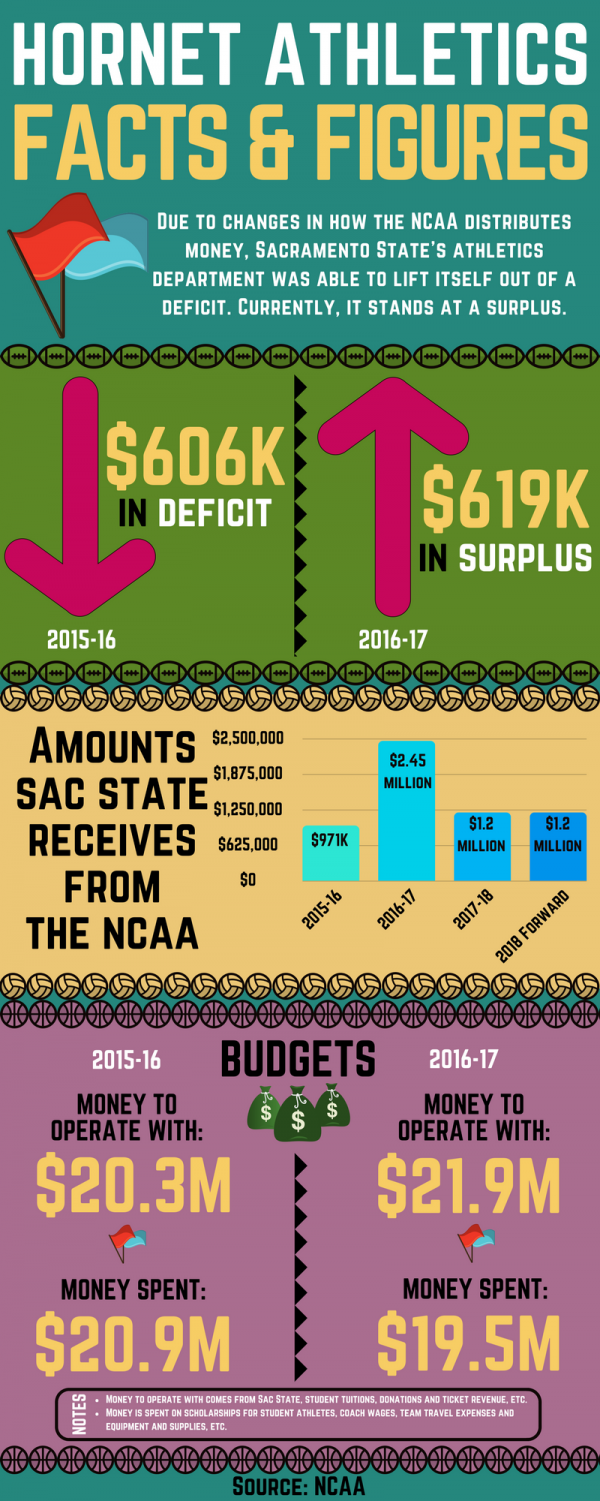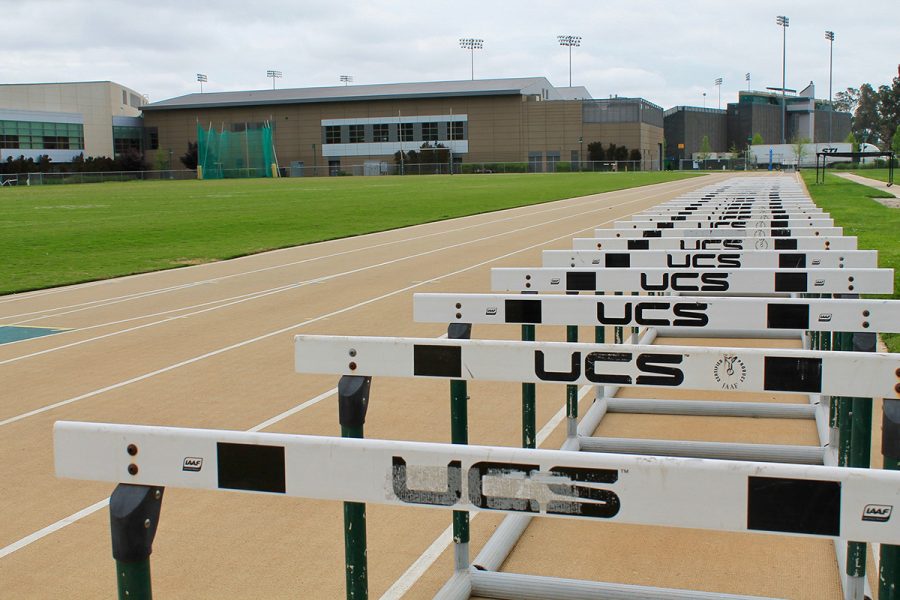Sac State Athletics department recovers from over $600,000 deficit
Sami Soto – The State Hornet
Due to changes in how the NCAA distributes cash, the Sacramento State Athletics department has recovered from a $606,694 deficit from the previous year, according to an NCAA report from the 2016-17 year.
The Sacramento State Athletics department has recovered from a deficit of over $600,000 from the previous year, according to an NCAA report from the 2016-17 year.
Due to changes in how the NCAA distributes money, the Athletics department received $2.4 million according to the 2016-17 NCAA report — more than twice what it received last year, bringing it out of the deficit.
Currently, the athletics program stands at a $619,335 surplus.
RELATED: EDITORIAL: Students footing the bill on a program constantly in the red
Among the NCAA changes are adjustments in how the money is calculated and when it is distributed, said Jeff Pritsker, the Sac State associate athletic director of business. The cash from the NCAA is given out at the beginning of the fiscal period instead of the end, which caused the department to receive two payments this year instead of one. Pritsker also said that the program will receive about $1.2 million yearly in NCAA distributions for the foreseeable future.
In addition to NCAA distributions, the department is also heavily funded by student tuition and the University, which helps cover the operating costs of the program. For the 2016-17 period, the University provided $8.2 million to the department — two-thirds of which goes toward the salaries of its head and assistant coaches, Pritsker said.
The report shows that student tuition paid $8.1 million. This money is used to help with the sports programs’ operating expenses, which total $19.5 million. Operating funds — whether from Sac State, NCAA distributions or from donations — totalled $21.9 million.

The remainder of the operating costs are left for the Athletics department to cover with ticket revenues from games, sponsorships, guarantees from away-game participation and donations, among other sources.
However, the rising costs of scholarships and travel still pose a threat to the financial future of the department, said Sac State Athletic Director Mark Orr.
“Salaries, tuition, travel expenses; those things continue to rise,” Orr said. “Expenses certainly aren’t going down in higher education and on a national scale.”
The cause of the prior year’s deficit, which totaled $606,694, according to the 2015-16 NCAA report, was due in part to scholarships for student-athletes, Pritsker said.
In both the 2015-16 and 2016-17 NCAA report, the program reported nearly $4.7 million spent on scholarships and student aid — making it the highest expenditure for the department.
While the number of scholarships awarded to student-athletes has not significantly changed, scholarship rates have increased due to the rising cost of tuition, housing and meal plans, Orr said.
For the 2017-18 year, Pritsker said he predicts that $5 million will be spent on scholarships and student aid, adding that it would be “the most they’ve spent in a long time.”
This prediction comes at a time when a number of collegiate athletic departments are making cuts to stay afloat. The Eureka Times-Standard recently reported speculation among Humboldt State University coaches and players that its football program may be cut or placed in moratorium at the end of the 2017 season in November due to a projected $900,000 or higher deficit for the year.
Only five campuses in the California State University system, including Sac State, have teams that play in NCAA Division I football. Humboldt State is currently the only CSU that plays in Division II. HSU is in danger of losing its football program amidst a $508,600 deficit, according to the University’s 2016 Intercollegiate Athletics Assessment, and has a projected $900,000 or higher deficit for 2017-18.
However, Orr said that he does not believe Sac State will face the same difficulties as HSU due to the popularity of the football program, especially in light of its latest season.
The Hornets — which finished with a program-best, 6-2 record in the Big Sky Conference this year — are coming off a 7-4 overall standing and a Causeway Classic win over rival UC Davis on Nov. 18.
“I think football’s success has brought a lot of those former alums and people interested back to the program,” Orr said. “The hope would be that we can continue to have success in our football program that we’ve had this past season that will turn into revenue streams — that, previously, we haven’t had the opportunity to explore.”
Orr and Pritsker both agree that football brings the largest crowds — and the most revenue — of any team on campus and also draws the most attention from alumni and community members who are potential donors.
The football team made up half of the earned ticket revenue for the Athletics department for the 2015-16 year, reeling in $119,685, according to the 2015-16 NCAA report. The amount was less in the 2016-17 NCAA report, with $78,923, but still the highest earner.
Higher yet is the amount of donations the athletics program receives, with a little over $1 million reported by both NCAA reports — football being the largest team-specific earner.
However, attracting money from alumni and community donors to help cover the operating funds is difficult because of the competition for donations across California, Orr said.
To help combat this, Orr — who is in his first year as athletic director — said he has plans to bring more revenue streams to the Athletics department. He is looking to target contributions from donors and alumni, which he refers to as the “lifeblood of athletics.”
“We’ve got to give them a good reason why they should donate to Sacramento State and certainly Sacramento State Athletics,” Orr said.
Encouraging an exciting and attractive atmosphere at games is one method that Pritsker and Orr want to use to encourage higher attendance. Large crowds were drawn to the Causeway Classic football game at Hornet Stadium this month, along with the volleyball team’s Big Sky Championship match at Colberg Court.
“Even though we don’t get revenue from students coming (to games), it’s really important for us to have students at our events because they draw the atmosphere, and they get everybody more excited,” Pritsker said.
Orr added that Sac State needs to continue to schedule quality opponents so fans will be more encouraged to visit and pay for play.
“If you had a good experience coming to games as a student, you’re more likely to come as an alum or continue to follow Sac State athletics or football or basketball or just come back for the homecoming (game),” Orr said.
As other departments at HSU and UC Berkeley struggle, Orr said he hopes to keep up with the cost of running a competitive Division I athletic program that features 21 teams.
“So, in order for us to do that, we really got to put a lot of focus on things we can do to drive more support, (and) that’s the goal,” Orr said. “It’s not to cut programs or undercut students for programs, and it’s certainly not to overspend.”
Additional reporting by Matthew Nobert
Read the full 2015-16 report below:
[su_document url=”https://statehornet.com/wp-content/uploads/2017/11/NCAA-Membership-Financial-Reporting-System-2015-16.pdf” height=”1000″]Blank application form. [/su_document]
Your donation will support the student journalists of Sacramento State University. Your contribution will allow us to purchase equipment and cover our annual website hosting costs.





























































































































